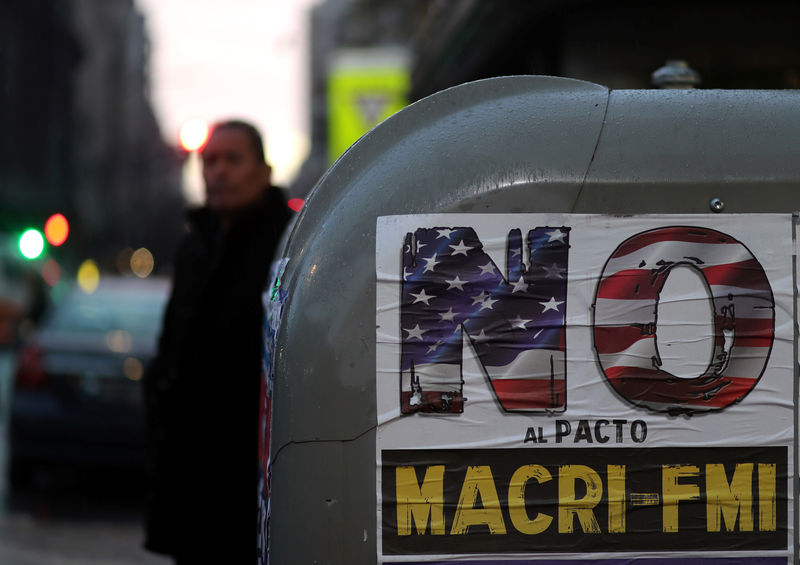 © Reuters. A poster that reads “No to the Macri-IMF pact” is seen in Buenos Aires
© Reuters. A poster that reads “No to the Macri-IMF pact” is seen in Buenos AiresBy Maximiliano Rizzi
BUENOS AIRES (Reuters) – Argentina is in talks with the International Monetary Fund (IMF) for a credit line to guarantee government funding and bring stability to financial markets, after the peso currency sharply weakened.
President Mauricio Macri’s announcement of a return to the IMF last month generated anger and concern among many Argentines, who still blame austerity policies imposed by the multilateral lender for an economic collapse in 2001-2002. That initiative plunged millions into poverty. The country stopped paying its debts in the world’s largest sovereign default.
Argentina remained a pariah in international markets for nearly 15 years under a succession of populist governments. But it received a wave of fresh capital after the market friendly Macri took office in December 2015, though the opposition has warned about the risks of rising public debt.
Macri has focused on gradually reducing the fiscal deficit, rather than a “shock” of severe budget cuts, but that approach depends on the willingness of international lenders to keep financing the government through debt.
Below is a summary of Argentina’s debt situation.
FOREIGN CURRENCY EXPOSURE
Official data show that Argentina’s public debt reached $321 billion in 2017, roughly 57 percent of gross domestic product (GDP) and up 33.3 percent from when Macri took office.
That is slightly above the levels in Chile and Peru, in line with Mexico and below Colombia and Uruguay, according to Argentina-based think tank FIEL.
Debt as a percentage of GDP remained relatively low under former President Cristina Fernandez, who implemented exchange controls in 2011 to slow capital flight, a move that caused a slowdown in investment and economic activity. That year, debt was 39 percent of GDP.
Months after taking office, Macri reached a deal with hedge funds that had refused to accept a haircut on Argentina’s defaulted debt. That allowed Argentina to return to global debt markets in 2016 and sell bonds to cover its wide fiscal deficit.
Nearly 70 percent of Argentina’s debt is in foreign currency. By comparison, in Brazil just 5 percent of debt is foreign denominated, while in Chile the figure is 18 percent, according to ratings agency Moody’s.
“Argentina has a relatively high portion of its debt in foreign currency, and that leaves it vulnerable,” said Gabriel Torres, a senior analyst at Moody’s.
Public data shows that more than 40 percent of Argentina’s public debt is held by private investors, and the majority of that is in foreign currency.
AUSTERITY AND DEBT
Experts believe that in exchange for the IMF credit, which would likely be at least $20 billion, the Fund will ask for an acceleration in budget cuts. Last month, the government announced a downward revision in its fiscal deficit targets for 2018-2020.
During the first two years of the Macri administration, the government tried to cut the deficit gradually to limit the social and economic impact of cuts. But growing foreign currency debt means the country will need to issue even more to pay off maturing debt.
The government has said that the IMF loan could guarantee financing to last through the end of Macri’s first term in December 2019. That would reduce the impact of potential future increases in global rates.
“Maturities in the short and medium term are high,” Cynthia Moskovits, a senior economist at FIEL, said in an interview. “On top of that there is a high current account deficit, which is induced by the public sector, making the need for foreign currency very high.”
The sustainability of Argentina’s debt going forward will depend in large part on the local economy. GDP expanded in 2017 after a long recession, but early expectations for 3 percent growth this year are unlikely to come to pass due to the recent financial volatility and a drought harming farm output.
The crisis also introduces new risks to the country’s provinces, many of which issued international bonds in the last 2-1/2 years amid investor optimism about Macri’s policies. Previously, provincial governments tended to borrow mostly from the federal government.
Source: Investing.com




























